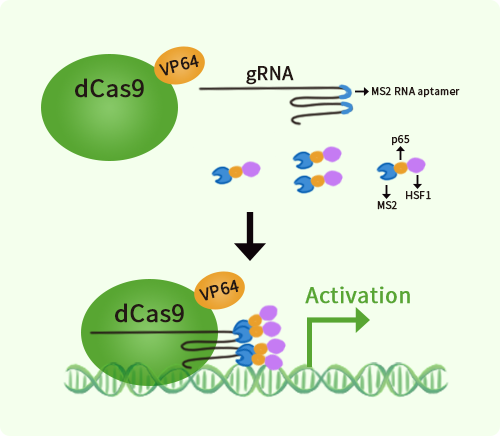Mouse Ccr2 activation kit by CRISPRa
CAT#: GA200774
Ccr2 CRISPRa kit - CRISPR gene activation of mouse chemokine (C-C motif) receptor 2
Find the corresponding CRISPRi Inhibitor Kit
USD 1,657.00
2 Weeks*
Specifications
| Product Data | |
| Format | 3 gRNAs (5ug each), 1 scramble ctrl (10ug) and 1 enhancer vector (10ug) |
| Symbol | Ccr2 |
| Locus ID | 12772 |
| Kit Components | GA200774G1, Ccr2 gRNA vector 1 in pCas-Guide-GFP-CRISPRa GA200774G2, Ccr2 gRNA vector 2 in pCas-Guide-GFP-CRISPRa GA200774G3, Ccr2 gRNA vector 3 in pCas-Guide-GFP-CRISPRa 1 CRISPRa-Enhancer vector, SKU GE100056 1 CRISPRa scramble vector, SKU GE100077 |
| Disclaimer | These products are manufactured and supplied by OriGene under license from ERS. The kit is designed based on the best knowledge of CRISPRa SAM technology. The efficiency of the activation can be affected by many factors, including nucleosome occupancy status, chromatin structure and the gene expression level of the target, etc. |
| Reference Data | |
| RefSeq | NM_009915 |
| UniProt ID | P51683 |
| Synonyms | Cc-ckr-2; Ccr2a; Ccr2b; Ckr2; Ckr2a; Ckr2b; Cmkbr2; mJe-r |
| Summary | Key functional receptor for CCL2 but can also bind CCL7 and CCL12 chemokines (PubMed:8631787, PubMed:8662823, PubMed:8996246). Its binding with CCL2 on monocytes and macrophages mediates chemotaxis and migration induction through the activation of the PI3K cascade, the small G protein Rac and lamellipodium protrusion (By similarity). Also acts as a receptor for the beta-defensin DEFB106A/DEFB106B (By similarity). Regulates the expression of T-cell inflammatory cytokines and T-cell differentiation, promoting the differentiation of T-cells into T-helper 17 cells (Th17) during inflammation (PubMed:28507030). Faciltates the export of mature thymocytes by enhancing directional movement of thymocytes to sphingosine-1-phosphate stimulation and up-regulation of S1P1R expression; signals through the JAK-STAT pathway to regulate FOXO1 activity leading to an increased expression of S1P1R (PubMed:29930553). Plays an important role in mediating peripheral nerve injury-induced neuropathic pain (PubMed:29993042). Increases NMDA-mediated synaptic transmission in both dopamine D1 and D2 receptor-containing neurons, which may be caused by MAPK/ERK-dependent phosphorylation of GRIN2B/NMDAR2B (PubMed:29993042). Mediates the recruitment of macrophages and monocytes to the injury site following brain injury (PubMed:24806994, PubMed:29632244).[UniProtKB/Swiss-Prot Function] |
Documents
| Product Manuals |
| FAQs |
| SDS |
Resources
Other Versions
| SKU | Description | Size | Price |
|---|---|---|---|
| KN302835 | Ccr2 - mouse gene knockout kit via CRISPR, HDR mediated |
USD 1,657.00 |
|
| KN302835BN | Ccr2 - mouse gene knockout kit via CRISPR, HDR mediated |
USD 1,657.00 |
|
| KN302835LP | Ccr2 - mouse gene knockout kit via CRISPR, HDR mediated |
USD 1,657.00 |
|
| KN302835RB | Ccr2 - mouse gene knockout kit via CRISPR, HDR mediated |
USD 1,657.00 |
|
| KN502835 | Ccr2 - KN2.0, Mouse gene knockout kit via CRISPR, non-homology mediated. |
USD 1,657.00 |
{0} Product Review(s)
Be the first one to submit a review






























































































































































































































































 Germany
Germany
 Japan
Japan
 United Kingdom
United Kingdom
 China
China
